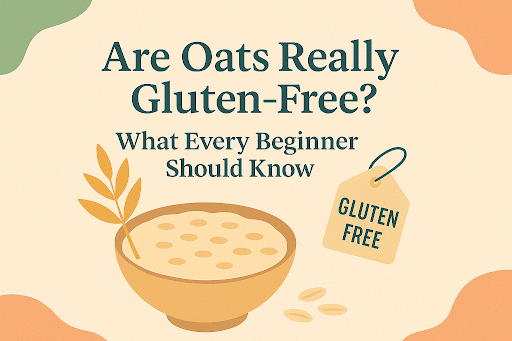by Claire Bennet | Easy Gluten Free
Hi friend,
Let’s talk about oats.
The kind you stir into warm porridge, bake into cozy breakfast muffins, or soak overnight in pretty little jars. Oats are comfort food, plain and simple. But if you’ve recently gone gluten-free, you’ve probably asked yourself:
“Wait… are oats actually safe?”
I know I did.
I remember standing in the cereal aisle, holding a bag of old-fashioned oats, trying to decode the label like it was a message from space .
So let’s clear up the oat confusion once and for all — and help you feel safe and confident in your gluten-free kitchen again.
Why All the Confusion Around Oats?
Oats are naturally gluten-free.
But that doesn’t mean they’re always safe for people with celiac disease or gluten sensitivity.
Here’s why:
- Oats are often grown in fields next to wheat, barley, or rye.
- They’re processed in shared facilities with gluten-containing grains.
- Even a little dusting of wheat flour can cause cross-contamination.
So unless oats are certified gluten-free, they’re a gamble — and not the fun kind.
What Are “Certified Gluten-Free” Oats?
Certified GF oats are:
- Grown in dedicated gluten-free fields
- Processed in gluten-free facilities
- Regularly tested to contain less than 20 ppm of gluten
You’ll often see them labeled with a certification logo or bold “GLUTEN-FREE” on the package.
Brands I love and trust:
- Bob’s Red Mill (make sure it’s their gluten-free line)
- GF Harvest
- One Degree Organic Foods
Wondering what else to look for on food labels? Don’t miss this guide:
“Is It Really Gluten-Free? How to Read Labels Like a Pro”
But… Why Do Some People Still React to Gluten-Free Oats?
Great question. Even certified oats can be a little tricky for some folks.
Here’s why:
- Oats contain a protein called avenin, which is similar to gluten.
- While avenin doesn’t contain gluten, a small percentage of people with celiac may still react to it.
- It’s estimated that 1 in 5 people with celiac might be sensitive to oats themselves.
So if you’re newly diagnosed, it’s smart to:
- Talk to your doctor or dietitian before adding oats back in.
- Start slow and track how you feel.
- Choose certified gluten-free oats only.
Easy Recipes Using Certified Gluten-Free Oats
If oats work for you, welcome to a world of delicious, budget-friendly, filling meals that feel like a warm hug. These are some of my favorites from the Sunday Light Kitchen:
- Claire’s Overnight Oats: 3 Flavors to Try This Week
- Banana Oat Breakfast Muffins – soft, fluffy, and freezer-friendly
- Oatmeal Chocolate Chip Cookies (GF & Dairy-Free)
And yes, oats even star in my beloved:
Fluffy Gluten-Free Pancakes (they’re a reader favorite!)
Shopping Tips for Oat Confidence
- Always look for “Certified Gluten-Free” on the front of the package.
- Double-check the ingredient list — it should only say “whole grain oats” or “gluten-free oats,” nothing weird.
- Be careful with flavored instant oatmeals — many contain hidden gluten or are processed on shared lines.
- Store your oats in a labeled, sealed jar to avoid contamination at home.
Pro tip: Check out my full list of pantry swaps in the free e-book:
Gluten-Free Made Easy: Your 7-Day Beginner’s Guide to Delicious & Stress-Free Meals
Final Thoughts from the Sunday Light Kitchen
Oats can be a wonderful part of a gluten-free diet — if you know how to shop for them, introduce them slowly, and listen to your body.
Don’t let the conflicting information scare you away. Like everything else in this journey, it’s about learning what works best for you, one delicious bowl at a time.
I’m cheering you on with a steaming cup of oat porridge and a sprinkle of cinnamon,
— Claire
Read Next:
- “Top 10 Gluten-Free Grains That Aren’t Just Rice”
- “The First Week Gluten-Free: What I Wish Someone Told Me”
- “Going Gluten-Free on a Budget: 12 Smart Shopping Hacks”



